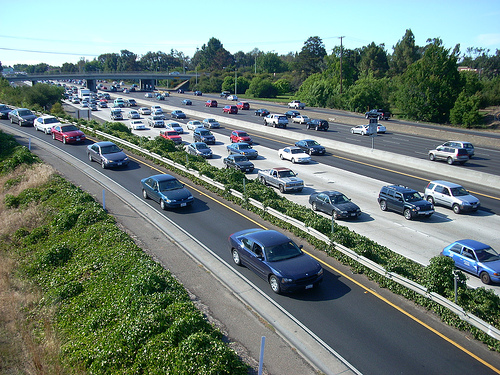A new review of the literature [PDF] by Resources for the Future (RFF) suggests that gas taxes motivate drivers to use less gasoline far more cheaply than auto efficiency standards like the Corporate Average Fuel Economy (CAFE) standards. There are a number of reasons to be suspicious of this conclusion.
In order to argue that CAFE has high costs, the study dismisses the National Highway Traffic Safety Administration (NHTSA) [PDF] estimate — that less than $900 is added to the cost of the average passenger car — as an “engineering” approach, preferring econometric modeling. There is nothing wrong with modeling in its place, but in the environmental field, economists have a long and consistent record of overestimating the cost of complying with regulations. At the very least, in this field, if the economists and engineers disagree, the engineers are the ones to bet on. Also, the canard that “NHTSA (2010) results beg the question of why automakers have not already incorporated seemingly profitable technologies” seems weak when applied to an industry that just had to be bailed out with massive government bridge loans.
A second argument contains at least some sense. Greenhouse gas pollution is only one of many social costs of driving, including other forms of air pollution, parking, and road maintenance. Because gas taxes, unlike efficiency standards, discourage driving, they provide co-benefits in reducing these costs.
One point the study itself makes is that this does not apply if these other costs are dealt with separately. If we end other driving subsidies — charge the real cost of parking, road use, and so forth — even by the models covered in the RFF literature review, a regulatory approach is the most efficient one.
The study also makes a claim I find difficult to believe: that in the absence of regulations or charges for non-CO2 related social costs, a gas tax alone costs less per gallon of gasoline saved than either a pure regulatory approach or a regulatory approach combined with a gas tax. It further claims that this is true no matter how high the social costs assigned to the externalities reduced by such regulations. In other words, it claims that no matter how high a value we assign to reducing greenhouse gases, automobile air pollution, and other externalities, a pure gas tax will produce superior results to any introduction of regulations into the mix. To the extent that regulation produces benefits, raising the gas tax enough to produce the same results will end up with better benefit/cost ratio.
Now, I’m not going to argue this is completely impossible. U.S. parking subsidies alone are worth $4,400 per automobile per year, and that is only one of many ways automobile owners don’t pay the full cost of their vehicles. So maybe the various social costs efficiency standards don’t capture really do overwhelm the limited types of benefits they provide, at least in the absence of regulations reversing other subsidies. But at the same time, I get very suspicious of a model that gives the same results regardless of input. Technically it may not suffer from non-falsifiability, but it comes too close for comfort. This is an awfully specific result to be derivable independently of empirical data.
——
Postscript:
The two objections that follow are not major. They do not drive a stake through the RFF literature review. However, they are examples of poor reasoning and double standards that cast doubt as to whether the conclusions reached by the RFF preceded or followed the analysis.
- The study uses a -.4 long term elasticity rate for gasoline demand response to price increases, which is a perfectly reasonable long term number. And the study also notes that costs of efficiency standards are much higher in the short run than the long run — again reasonable. However, what the study does not note is that demand response to gasoline prices is also much worse in the short run than the long run, 15-20 percent being the usual range. Spending paragraphs on the difference between short and long term costs of regulations, while failing to note that the same applies to Pigovian taxation, is a pretty strong double standard.
- The study notes (quite fairly) a rebound effect of about 10 percent for U.S. gas efficiency standards. That is, 10 percent of the savings produced by CAFE are lost to increased miles driven. In discussing gasoline savings alone, that should be considered. However, the study also looks at overall economic efficiency. If that kind of narrow economic efficiency is to be considered, then the economic value of those extra miles needs to be included. If the economic value of that extra freedom to travel is to be excluded, then that same standard should be applied to other economic benefits considered.
Again, the above two objections are not fatal. Unlike the major objections I mentioned, even when properly considered they do not change the outcome of the study. But they lead me to wonder what flaws more intensive examination of the study would reveal.



